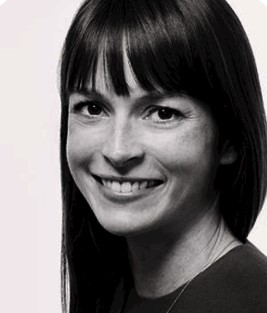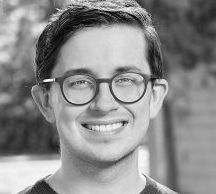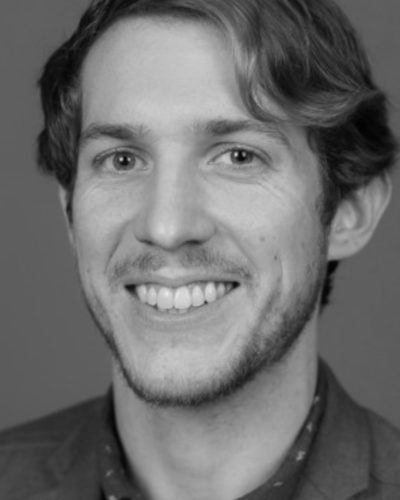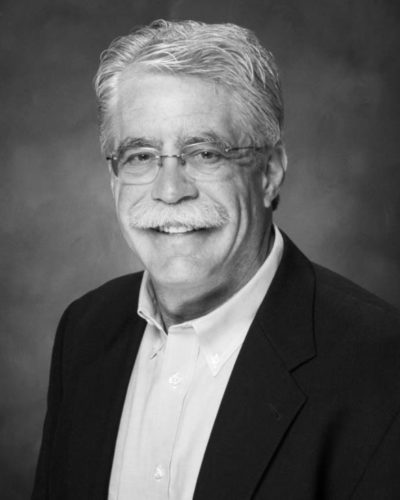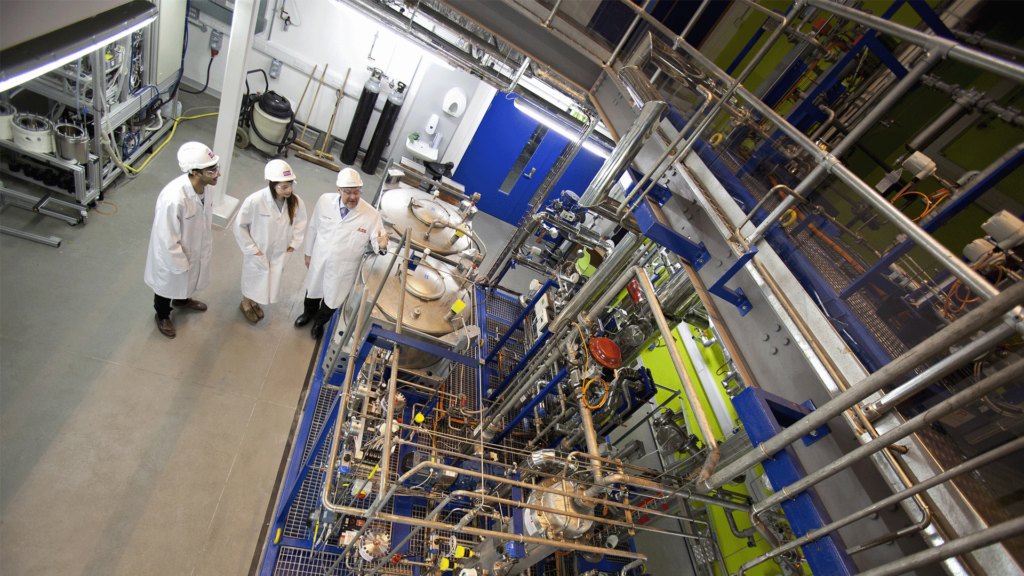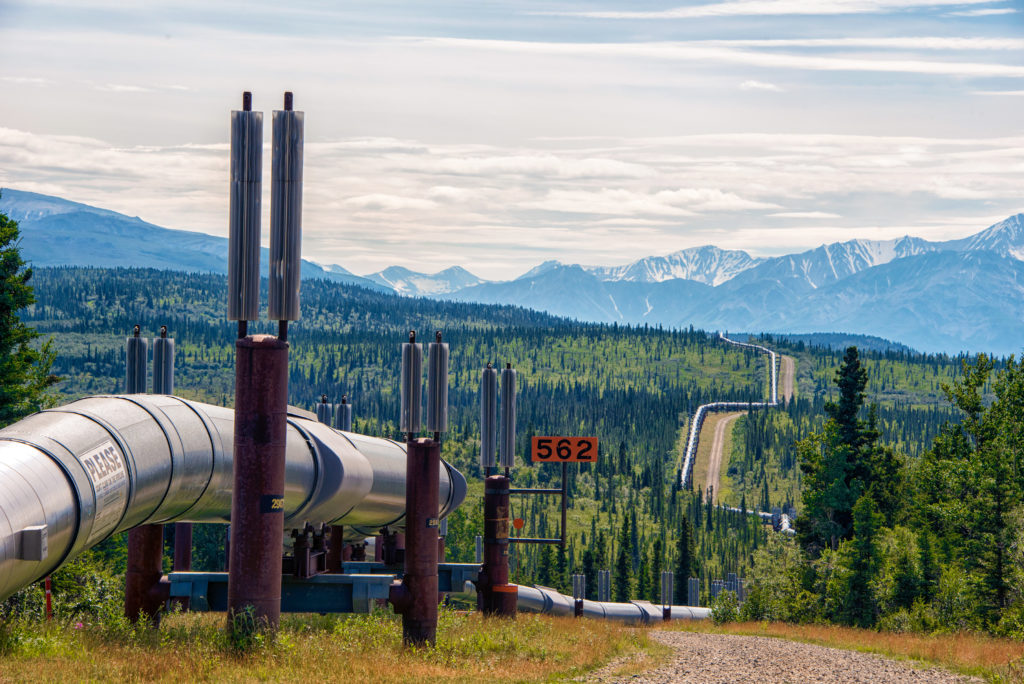TRANSCRIPT
[00:00:00] James Lawler (to Carbon Capture Lab scientists): I produce a podcast called Climate Now, and so if it’s alright, I’ll just, I’d love to just pass this around as folks are describing what they do.
[00:00:14] Simon Pang: You don’t have to go first. Yeah. So this is our Carbon Capture Lab. We do kind of a variety of different activities in here for both point source carbon capture and direct air capture, so we’re gonna let some of the researchers tell you more about what they’re doing.
[00:00:33] James Lawler: Welcome everyone to Climate Now, a podcast that explores and explains the ideas, technologies, and the practical on-the-ground solutions that we’ll need to address the global climate crisis and achieve a net-zero future. I’m James Lawler, and today in our interview segment we’re going to meet some of the researchers at the Lawrence Livermore National Lab, and learn about their work on carbon capture technology.
But before we do that, we’ll start with our new news segment, This Week in Climate News. And to talk through some of the climate news coming out this past week, I am joined by Darren Hau, staff manager of charging operations and product strategy at the autonomous electric vehicle company Cruise, and by Jessie Lund, truck program manager at CALSTART. Darren, Jessie, welcome back to Climate Now.
[00:01:16] Darren Hau: Hi James and Jessie, great to be back on the show with you.
[00:01:19] Jessie Lund: Likewise. Thanks for having me.
[00:01:21] James Lawler: So, this week is the second week of COP, which we talked about a little bit in last week’s episode. This week at COP, we saw Brazil’s President elect, Luiz Inácio Lula da Silva, speak about how as president, he would prioritize the Amazon, which is hopefully good news for combating climate change. Under current Brazilian President Bolsonaro, Amazon deforestation has reached record highs.
So Jessie, anything else COP-related?
[00:01:46] Jessie Lund: Yeah, I’m biased, but I’ll take the opportunity to say it’s been a huge week for electric trucks and COP has been no exception. We saw the US sign on this week to CALSTART’s global MOU, committing to a hundred percent medium heavy duty, zero emission sales by 2040 and 30% by 2030. This is a huge deal. The US signed on along with nine other new nations, bringing the total number of MOU signatories to 26, so we just are very excited to see all this progress. It’s really attributable to a lot of the leadership at the local and state level here in the US that we are able to accomplish this, and just really looking forward to working with all of these nations to advance zero emission trucks.
[00:02:35] James Lawler: Another article that we saw this week was in Bloomberg on November 15th, ‘The Battery Supply Chain is Finally Coming to America.’ There are a couple interesting quotes there. Cobalt is one of the most expensive and controversial ingredients for batteries.
The majority of the world’s supply comes from the Democratic Republic of Congo, where allegations of human rights abuses and the mining industry have been quite common. And to qualify for the full incentive under President Joe Biden’s 2022 Inflation Reduction Act, half of a battery’s minerals by cost must either be recycled in North America or mined from a country with which the US has a free trade agreement. The cathode that Redwood Materials plans to provide to Panasonic will be made with a hundred percent recycled cobalt and 25% to 30% recycled nickel and lithium.
[00:03:20] Darren Hau: Obviously, we’ve interviewed Andy Stevenson who was at Redwood Materials and helped start that company with JB. I mean, this is a great development, right? We should have more recycling in the US. We should be able to get more raw materials in the US.
It’s probably still gonna be a small drop in the bucket, is my understanding, given how fast the ramp curve is. There’s not as many vehicles retiring and able to be recycled as new vehicles coming online. But what Redwood materials is doing is partnering with other sources of electronics and batteries like laptops.
And I suppose it’ll use that to fill the gap for now, but all in all, incredibly important development. Actually this makes me think about another article that I read recently, and it may be a bit of a provocative question. This was also a Bloomberg article and it was titled ‘If We Want Lithium, Let China Finance It.‘
So we’ve obviously heard a lot about national security concerns and kind of supply chain resilience, and I think there’s been a bit of a knee jerk reaction to say, ‘Hey, we can’t have Chinese investment in domestic extraction and processing.’ And this author who, I believe Liam Denning, raised some really interesting points.
And just to summarize it, he thought that maybe it’s not such a bad thing to have China investing in North American resource extraction for a few reasons. Number one, they have a head start in processing. You know, they’re by far the dominant power in that, so any tech transfer in extraction and processing would probably actually go the opposite way and help us, right?
We’d learn more by having their investment here. Number two, worst case of a conflict does break out, which we’d obviously all like to avoid, it’s not like investors can just ship all the rare earth materials out, or lithium out. This is perhaps an extreme example, but you know, if you look at OPEC, the oil nationalization, there wasn’t much that Western oil companies could do beyond not selling equipment or sending trained engineers to help the Petro states.
So I think as long as we do this correctly, as long as we make sure we’re building a domestic extraction and refining workforce, perhaps the risk of Chinese investment is not as big as some people are making it out to be. Right. And then of course the last piece is we just need massive investment, so eliminating a major source of capital may be counterproductive.
[00:05:48] James Lawler: Right. Jessie, any thoughts on that?
[00:05:51] Jessie Lund: I mean, I think overall it just speaks to the impact of the Inflation Reduction Act. I think there’s so many exciting things and investments to come in the US thanks to this federal legislation that for a long time seemed like it wasn’t gonna happen.
So I’m just really excited to see all of the investments coming to the US, whether it is from some companies from abroad or from local North American companies as well. I think we’ll continue to see massive investment, particularly in terms of battery production, all of the jobs that come along with it, the tax base that comes along with it. I think this is key to really building broad public support for climate action, is the more we can help folks understand that climate action, the energy transition also means jobs, economic development. I think that’s a winning argument and I’m excited to just see that happen more here in the US.
[00:06:48] James Lawler: So speaking of China, the US and China resumed their climate talks this week. China suspended all cooperation with the United States, including around climate change, in August to retaliate for Nancy Pelosi’s trip to Taiwan. So this is potentially significant.
[00:07:03] Darren Hau: It is a positive for the climate front. But I think it’s just as important, if not more important, on the national security front and geopolitical front because if there’s something that two people are working together on, and you have, you can point to a success in that collaboration, it builds rapport and you know, the more areas we can collaborate on, the less likely conflict will break out.
[00:07:26] James Lawler: I think that’s a great point. So our last bit of news comes from the California Air Resources Board, who just this week released a revised climate strategy, which if adopted, would aim to reduce fossil fuel use 94% by 2045 from 2022 levels.
It’s ambitious and it would require removing 20 million tons of carbon by 2030. Given that news, it’s actually perhaps fitting that today’s episode examines carbon capture technologies being studied by scientists in California. Thank you, Darren. Thanks, Jessie. We’ll see you guys next time.
[00:07:57] Darren Hau: Thanks for having us on, and good to see you again, Jessie.
[00:08:00] Jessie Lund: Likewise. Thank you.
[00:08:04] James Lawler: On today’s episode, we’re going to do something a little bit different. I recently had the opportunity to visit a number of laboratories within the Lawrence Livermore National Lab, which is a federal research facility outside of the San Francisco Bay area, funded by the Department of Energy.
The Lawrence Livermore National Lab has a foundation, LLF, which as our listeners know, is one of the sponsors of Climate Now. The lab has been around for 70 years and has been involved in major research efforts in everything from supercomputing to the Human Genome Project. The scientists at Lawrence Livermore have also been at the vanguard of renewable energy and climate change research with a special focus on carbon removal technologies under the lab’s carbon initiative.
We can’t hit the goal of creating a stable climate by mid-century by just reducing CO2 emissions. We also must remove an additional 10 gigatons — that’s 10 billion tons of carbon dioxide from the atmosphere — every year according to the National Academies of Sciences, Engineering and Medicine. That’s twice what the United States admits from burning fossil fuels every year.
I spoke with some of the lab’s leading scientists who are involved with assessing and testing technologies to speed up different processes for pulling CO2 from the atmosphere. These processes and technologies include direct air capture, converting biomass waste to fuel, and even supercharging the weathering of rocks to help absorb more carbon dioxide.
So in this episode, we’re gonna actually take what was a day-long tour and take you through all of the different areas within the lab that are studying carbon dioxide removal. You’ll meet the scientists that I met and you’ll get to learn everything that I learned on that day.
Among the questions that I asked and they answered are: can direct air capture be commercially viable and scale sufficiently to make a meaningful dent in removing existing CO2 from the atmosphere? How can we precisely measure or even verify that methods designed to capture carbon dioxide work? Aside from high tech solutions, what are some of the natural solutions, natural ways for capturing and removing CO2?
Our tour will take us to the Carbon Capture Lab, where we speak to a number of researchers testing the cutting edge technologies and materials being developed to capture CO2 at the source or remove it from the atmosphere.
Later in the podcast, I’ll talk to materials chemist Dr. Sarah Baker about how we can leverage the earth’s natural abilities to capture and store carbon. We ended our day, and we’ll end this podcast with a conversation with a couple of scientists who are studying one of the planet’s lesser known carbon sinks: rocks.
First up, however, is my conversation with doctors Roger Aines and Simon Pang on the challenges and potential of direct air capture technologies. Roger is the Lab’s energy program chief scientist and lead on the laboratory’s Carbon Initiative to identify global-scale solutions to remove CO2 from the atmosphere.
Simon is a staff scientist in the material science division who also leads the direct air capture and carbon capture effort on the Carbon Initiative. Their job is to identify the technological bottlenecks for large-scale carbon capture and investigate possible solutions. Here’s Simon, laying out the basic premise with an example
[00:11:02] Simon Pang: From the research and development side, we are looking at problems in direct air capture that will affect multiple classes of technologies or multiple technology providers. We don’t see ourselves as providing a test bed or that kind of technology because there are so many people doing it. So we can better focus our efforts on problems that multiple groups will encounter. One of these kinds of problems is looking at degradation of direct air capture materials.
We see this as a central challenge, particularly in the solid sorbent direct air capture space, has a large effect on the cost, ultimate cost of the direct air capture process. If you have to replace them every half a year, every year, that introduces a significant cost to the process, in addition to the energy cost and these other things. We work on identifying the chemical and physical mechanisms that cause degradation, and then look to develop new materials or new processes to avoid that degradation.
[00:12:02] James Lawler: Direct air capture involves machines sucking in air and using solid materials, called sorbents, or liquid solvents to absorb the carbon dioxide, which after a few more steps can then be stored or sequestered deep underground. The technology is still in its infancy. The world’s largest direct air capture and storage plant is in Iceland, dubbed Orca and built by a company called Climeworks. That plant has the capacity to remove about 4,000 tons of CO2 per year, which is less than the total emissions of about 1000 passenger vehicles. So very, very little. The plant reportedly costs between 10 and 15 million to build. We continue the conversation with Roger explaining that Orca is just the first step towards scalability.
[00:12:44] Roger Aines: In five years, we’re going to have dozens of plants the scale of Orca, a few thousand tons a year, because that’s what it takes to really demonstrate that the technology works. But the thing that I was so encouraged by was when the XPRIZE had the first phase of their big carbon capture competition.
They had 200 competitors qualify to be evaluated. Now, lots of them were not any good, but the point is they had companies, they had ideas, they were able to answer all the questions. These were 200 serious efforts to do air capture. What — two years before that it was five. So, that scaling up in a hurry all over the world, people recognize that this is a thing that would be valuable to do and the simplicity is so clear, there’s too much CO2 in the atmosphere, take it out.
So I think it’s going to scale rapidly. And I think one of the things is to drive the acceptability up. We tend to think about these things on some open plain in West Texas. I want to think about them in cities. I want to think about them on the site of every old oil refinery in every city.
They have the pipeline access, they have the energy access, they have shipping access, and they have enough space to do these things. And then I don’t want to see them — how tall is Orca, 30 feet tall? I want to see them 300 feet tall. I want to see skyscrapers doing this job in cities who care about this job doing so.
What we discovered about director capture is that the price is not the most important thing today. It’s making it acceptable, making it possible. People want this to happen. So I think driving up the acceptability is as important as driving down the cost.
[00:14:40] James Lawler: And Simon goes into the benefits of direct air capture versus other carbon removal technologies and how direct air capture costs might come down. Roger then zooms back out and muses on the indirect benefits that this technology might bring.
[00:14:53] Simon Pang: I think direct air capture has a couple of advantages compared to potentially some of the other carbon removal technologies. We don’t have the same kinds of questions over whether or not we have done our job. We can measure the amount of CO2 that we capture, we can measure the amount of CO2 that we store.
There are fewer questions around that. We have the advantage of being able to reverse historic emissions, so you know, we can do as much as we can in terms of decarbonizing, but that’s not gonna get rid of the fossil-based emissions that we’ve already put into the atmosphere.
[00:15:25] James Lawler: Roughly what are the costs today of director capture and what do you think they’re likely to be in five and 10 years?
[00:15:33] Simon Pang: Yeah. This is always a tricky question. The scale of the Orca facility, my understanding is that those costs are in the 600 to 1000 dollar per ton range. Again, this is small scale, it’s first of a kind, and so we can expect that those are gonna be larger than the ultimate costs.
I know Oxy Low Carbon Ventures for the half a million ton liquid solvent plant has quoted something like 300 to 400 dollars per ton. I see pathways for both sets of technologies to come down into at least the $200 per ton range, if not lower.
[00:16:07] James Lawler: What are the other ways cost could come down?
[00:16:09] Simon Pang: I’ve mentioned for the solid sorbent case, the sorbent lifetime is currently a major driver. The way the energy that you use in the solid sorbent process is another major cost driver, and I think that as you start to scale up these things. So, Climeworks has announced their Mammoth plant, which is gonna be 36,000 tons per year, which is kind of a larger version of Orca, but you should be able to start getting the ability to recover more of your wasted or lost heat or energy as you get to some of those larger scales. So that’ll bring the cost down as well.
[00:16:48] James Lawler: What are some of the other big questions that you guys are focused on when it comes to direct air capture?
[00:16:52] Simon Pang: Yeah, I think a lot of the questions that we’re interested in are these regional challenges. If we’re looking at energy supply, I think a lot of people have tossed around: we can use high temperature heat pumps to generate steam or something and integrate that in. So how do we most effectively use that energy? How do we recover the wasted energy? So we’re looking at process designs to be able to do that.
When we look around different parts of the country, matching the right technologies to the right locations, and then trying to answer questions like, in a really cold climate where it’s below freezing for much of the day in the winter, how does something like a process that uses steam during the regeneration, how does that now function when you put it back into that freezing air? And what are the issues that you’re gonna run into there?
[00:17:45] James Lawler: Back to Roger.
[00:17:46] Roger Aines: I think you’re gonna be looking for local benefits other than just direct air capture and jobs are one, you know, how does that fit in? But two others that come out as being important is, first of all, you’re processing an enormous amount of the air in the local environment.
Can you make it cleaner? Can you remove dust? Can you remove other pollutants while you’re doing this? Even if you could only remove a small fraction of it, that might be really attractive to communities where you need to install these things.
[00:18:20] James Lawler: Especially cities, right?
[00:18:21] Roger Aines: Absolutely. Or the Central Valley of California, where we have some of the worst air in the world. Particulates, passing it over a filter, that’s a great way to get rid of particulates. But then it’s gonna gum up your filter. Interesting trade off. Second one that a lot of companies are looking at right now is water. These materials inherently capture water at the same time they capture CO2.
That’s often regarded as a problem because it’s taking up some of the space that would’ve been CO2. But what if you want to produce water in the course of doing this? Well, is that a thing you can do and actually afford to do it? Lot of communities, that would be a very attractive idea. So these other things of adding value might be as important as reducing cost.
[00:19:10] James Lawler: During my visit, I had a chance to tour the carbon capture lab. This is where scientists are conducting small scale tests on new kinds of equipment and materials for both point source capture, which means capturing CO2 emissions in exhaust or flu gas before it ever enters the atmosphere, and direct air capture.
You’re now going to hear from some of those researchers who are doing the hands-on work. Elwin Hunter Sellars is a post-doctoral researcher who works on carbon capture projects. He introduced me to a device called a Breakthrough Analyzer. Picture something that looks sort of like a mini fridge on a lab bench with a bunch of tubes and wires running through it.
[00:19:44] Elwin Hunter Sellars: So what this does is it allows us to expose a fixed bed, or a packed bed of our material, to whatever process conditions we’re interested in. For a lot of our applications, we’re exposing it to low concentrations of CO2, so 410 ppm, so what we expect in the air for direct air capture.
So right now we’re doing some work on some amino-polymer aerogels from Palo Alto Research Center, and we’re exposing them right now to — this experiment right now is actually a standard test, but we’re testing their absorption capacities to how much CO2 they can remove and the mass transfer of that process. So basically, how quickly can we remove the CO2 during a process? And right now what we’re trying to do is — so this is very small scale testing, so we work with very small sample sizes. So if someone’s got a novel material that they want to test out or a new formulation, this is a great piece of equipment because it can very closely represent a real world process. So we can generate humidity, we can generate different temperatures, we can generate different sweet gases and regeneration conditions so we can get pretty close to the real world.
[00:20:46] James Lawler: Staff scientist Nathan Ellebracht works on CO2 capture with a focus on direct air capture in both materials and processes. He walked me through a piece of equipment called the Thermographic Metric Analyzer. Picture something that sort of looks like a high end office printer.
[00:21:01] Nathan Ellebracht: It’s sort of the screening workhorse for a lot of the CO2 projects, because essentially what it does is measure the mass of a material while you flow a gas over it, and you can control the temperature.
So what we do is we remove all the CO2 from a solid material that will capture CO2, and then we basically flow either simulated air or 4% CO2, which would be like a flue gas stream, over the material in this automated container, basically. And then we can measure how much the mass changes. And then because we know that it is primarily only absorbing CO2, we can basically assert that that mass change is the CO2 that it’s capturing.
But it is a great screening tool for how well is this material performing? So it’s used actually across a variety of projects. Right now we’re using it both to study materials just for direct air capture, and also studying materials for reactive capture or reactive direct air capture, which is essentially a process that would capture CO2 from the air and then on the same material, be able to do the catalytic conversion of converting the CO2 to some product.
So basically, CO2 from the air to, for example, methane. So you’d be producing methane from atmospheric CO2 rather than fossil methane. So that’s some of the materials we’re testing here, and we’re just using this as a nice screening tool for that.
[00:22:23] James Lawler: Simon Pang, who spoke earlier about air capture technologies, notes that the lab goes beyond analyzing new carbon capture materials.
[00:22:31] Simon Pang: In addition to some of the analytical tools that we have for evaluating new materials, we also create new materials. So we have the ability to synthesize new small molecules, new polymers that we think may have advantageous properties for various CO2 or direct air capture objectives. So for example, we might try to synthesize new polymers that have improved resistance to oxidation, or might have a different binding affinity or binding energy for CO2 to try to change the energetics of the process, and if some of these might be good for direct air capture, some of them might be good for flue gas capture. It kind of depends on what we end up making.
Some materials might be suited for cold weather, whereas some might be better off on hot weather. So we do kind of, we span the gamut here of basic science research up through materials evaluation and testing, and then more applied research as well.
[00:23:25] James Lawler: The lab also leverages other kinds of technologies to design experiments and demonstrate the effectiveness of the carbon capture materials and processes that they’re studying. In particular, they use additive manufacturing or 3D printing. Staff scientist Du Nguyen, who has a background in physics, explains some of the advantages of working with 3D printed structures and materials into the prototyping process. It’s also worth emphasizing that a lot of this research is not just about proving the technology, but ensuring that it can scale.
[00:23:53] Du Nguyen: This area is essentially dealing with sort of tests for capturing CO2 from point sources. And so we have gas cylinders available for flue gas mimics, or have controlled amounts of CO2 mixed with inner gas streams to work with.
And so a lot of the systems you see here are essentially meant to mimic CO2 capture columns, where there might be assortments that in a packed bed format where we have the flu gas going through and the CO2 is being captured. We have this column here where it’s more of like a flowing bed system where we have a liquid solvent going through the column from the top and then having flu gas coming from the bottom.
So inside of this column is essentially a similar mimic to what would be used commercially. So they’re essentially corrugated sheets of material that just provide surface area for that liquid and gas interact as closely as possible with. This work here is definitely a larger scale, but it also tries to take advantage of 3D printing.
And so when we think about 3D printing, we can think of perhaps two significant advantages. One is geometries that are very difficult to fabricate otherwise, and the other one is rapid prototyping. So I can show you two different things here. So, this is an example of a 3D printed geometry called a triply periodic minimal surface.
And so it’s a lot more complex than the corrugated sheets, but what it does is it allows liquid to really distribute more evenly while flowing through it. And you’ll see that normally when you think about it, it’s a very complex structure that would be hard to make outside of 3D printing. But we’ve seen from some basically lab scale testing that there’s an improvement around the order of 20% over just the typical corrugated sheet structures by just changing up the geometry.
The other aspect that we’re really looking at now is also trying to scale up these sorts of technologies so that they can actually be used for CO2 capture. And so when I mention that normally we think about a structure as something that you could only do through 3D printing, we did find that there is a way of potentially match manufacturing the same overall kind of structure by basically segmented into very specific regions that are repeatable and mass manufacturable.
[00:26:04] James Lawler: I also had the pleasure of speaking with Dr. Sarah Baker, group leader for the Materials for Energy and Climate Security Group in LLNL’s Material Science Division.
Sarah was the lead author of a report published a couple of years ago that provided a blueprint for how California could get to carbon net-neutral by 2045. The strategies not only include direct air capture, but other approaches to negative emissions, such as taking better advantage of the land’s natural abilities to capture and store CO2.
In particular, her team is working on ideas for biomass carbon removal and storage.
[00:26:36] Sarah Baker: We have multiple roads that we’re looking at. We’re looking at natural solutions, so essentially ways of treating forests that can naturally store carbon above the baseline, which is whatever we’re doing today. We’re looking at CO2 storage in soils, and again, it has to be additional, and that’s a lot of times where the experts need to come in and really look at the data and what we know and what we don’t. Durability is also a big question with those natural solutions, and that’s a lot of what they’re looking at. We’re looking at also what we call biomass carbon removal and storage, BiCRS.
That is looking at using biomass, which already used solar energy to capture CO2 and stored it for us. And the question is how do we get that carbon back out in a way that’s economical and has co-benefits, like displacing fossil fuels, like taking away a waste disposal problem or an air quality problem.
How do we do that in a cost-effective way, and in a way where we don’t displace biomass that we need for food? Because if we do that, we’re going to have what we call leakage. We’re going to have that biomass grown somewhere else and have detrimental impacts. So where we’re really looking for this analysis for the US is, in a regional way because the biomass distributed across the US and the regions are very distinct, we’re looking to see what the biomass and conversion technology and product, we call that a pathway. How can we identify those that are distinct for each region that are lowest costs, and also have benefits for those regions and communities.
[00:28:23] James Lawler: On the biomass front, you described that there’s several paths from types of feed stock to types of transformation, to types of output. Can you describe some of those pathways?
[00:28:36] Sarah Baker: Yeah, so as I mentioned, we really want there to be co-benefits to this and we need there to be a carbon benefit. So, the first place we wanna look for biomass is waste biomass. That’s just easy, right? You don’t have to be too concerned that you’re displacing food or there’s gonna be leakage.
[00:28:56] James Lawler: Everyone wants to give you their waste.
[00:28:58] Sarah Baker: Everyone, in theory, and also the alternative is that that waste is going to degrade or burn. And it’s gonna degrade to methane, which you really don’t want, or create air quality problems. The scale of those wastes is around, I would say 100 to 150 million tons per year. Now, if you start to throw in what we call bioenergy crops, but I think what we should start to call carbon crops, which is actually adding perennial crops to land that is either not currently used productively, what we call marginal lands, you can add a lot of biomass to the mix. Ballpark, we have conservative to maximum potential scenarios that go from 50 to 500 million tons a year.
[00:29:46] James Lawler: Wow. What kinds of transformation technologies exist then into which those sources would be feed stocks?
[00:29:53] Sarah Baker: Some examples are gasification and these thermochemical technologies like gasification and pyrolysis. And from those you can make gasoline, you can make precursors to jet fuel, you can make hydrogen, you can make methane. And all of these products then have different sort of economics. But of course what we’re interested in is how much carbon dioxide can you get and put underground. And if a process makes a molecule, that’s later gonna be combusted and remitted, then you’re probably gonna get less carbon dioxide that you can put underground, and the cost per ton of that carbon dioxide is going to go up because you’ve invested in this plant and you’re getting less CO2 out of it.
[00:30:40] James Lawler: Right. You’re getting some other valuable output though.
[00:30:42] Sarah Baker: You are. And we are factoring in that revenue. So every single technology has to have a techno-economic assessment or analysis, and then you also have to look at the product and the end of end of life of the product.
[00:30:55] James Lawler: On my final stop of the day, I spoke with a couple of other researchers with the lab’s Carbon Initiative, who study an unexpected carbon sink: rocks.
Briana Schmidt and Corey Myers are staff scientists working on carbon storage through mineralization. Here’s Briana:
[00:31:10] Briana Schmidt: Mineralization is essentially speeding up the natural process of chemical weathering, and that’s the process by which CO2 in the atmosphere gets transferred into CO2 in rocks or carbon in rocks.
Rocks are one of the earth’s largest carbon sinks. That process happens really slowly over geologic times, over millions and tens of millions of years, CO2 in the atmosphere gets transferred into carbonate rocks. Those rocks eventually get subducted into volcanoes, and that’s how the CO2 gets back into the atmosphere. So what we wanna do is speed up the part where CO2 in the atmosphere gets transferred to CO2 in rocks.
[00:31:44] James Lawler: And what are the most promising vectors to do this?
[00:31:50] Corey Myers: Well, you know, that speed question really comes down to like, what is your source of calcium or magnesium? Because that’s what the CO2 is gonna turn into. It’s going to be a calcium or magnesium carbonate, and once it’s there, it’s stable. So we’re done. But it turns out the calcium, magnesium is in a lot of different forms. Some of it’s in seawater, some of it’s in rocks, okay? And the forms that react quickly are typically already reacted, right? Something that happens naturally.
So the big part of CO2 mineralization is can we find sources of calcium or magnesium that are quick reacting and of a sufficient quantity? So that’s a lot of geologists going out there and finding us this treasure of unreacted calcium and magnesium sources.
[00:32:40] James Lawler: How hard is that to go, and what are the big challenges or hurdles to overcome on this path to finding abundant sources of magnesium and calcium, and then reacting them with CO2? I’m imagining like massive mining operations that are as far as the eye can see, and extremely expensive and carbon intensive, and then huge ships that take all that stuff to some place. And seems very complicated and hard.
[00:33:11] Briana Schmidt: Yeah. Well, I guess like all of these solutions, this will play only part of the role, right? It has to be part of a suite of solutions for carbon removal. There are sort of different flavors of carbon mineralization. You can do it at the surface where the rocks already are, and so you’re talking about large scale mining. You could take the rocks from where they are to some source of CO2, that’d be the second way to do it. Or you can do it where the rocks are, but do it underground. And so rather than mining the rocks, you put the CO2 underground into the rocks.
[00:33:41] James Lawler: And so what are you doing to speed up the natural reaction?
[00:33:44] Corey Myers: The reaction rate currently is set by what’s the connection between the air and the ground? What’s the surface area there? That’s what limits it. So, your solution to speed it up is: dig up the material, grind it up small, and then give it a way to contact the air. So somehow you need to blow some air over it so that it contacts it. This is definitely the land of engineering, this is not the land of science anymore. And we believe we can speed up these reactions such that we can get to very high conversion extents at very low costs. So it seems like a pretty simple solution. I mean, this is, I think, the oldest technology that human has, is breaking rocks. Okay, so this is not crazy science fiction. We can do this.
[00:34:37] James Lawler: What are some of the engineering solutions that you would deploy, and then how would you actually know or verify that this was working at the scale that you had hoped?
[00:34:48] Corey Myers: The nice thing about at least this method is that CO2 reacts with the rocks and becomes the rock. So at the end of the process, you can hold it in your hands, you can weigh it, you can measure it by 20 different ways. Okay. But it’s very easy to verify that this is how much CO2 we have in here. So that is one of the nice things that, I think it’s come up a couple times today, is being able to have confidence in how much CO2 you’ve taken out.
So you know, if somebody asks you where their CO2 is that they paid for, you can hold it in your hand and you can say ‘Hey, here it is.’ In fact, you can take it home with you, right? Like that is a possibility with this type of process. I don’t know how you can get higher confidence than that, that’s something you can hold in your hands.
[00:35:40] James Lawler: That was a series of interviews conducted with the scientists at Lawrence Livermore National Laboratory in the Carbon Initiative Program on their carbon dioxide removal and carbon capture and storage research. While direct air capture holds promise, we’re still in the early stages, so efforts to improve point source capture technologies and materials to stop CO2 from getting into the atmosphere in the first place will be important in the near term.
We’re still learning about the extent of the Earth’s ability to absorb and store carbon, but natural solutions must be part of the overall strategy as well to address the climate crisis down to every tree and rock. That’s it for this episode of the podcast. For more episodes, videos, or to sign up for our newsletter and live events, visit climatenow.com.
We hope you can join us for our next conversation.
Climate Now is made possible in part by our science partners, like the Livermore Lab Foundation. The Livermore Lab Foundation supports climate research and carbon cleanup initiatives of the Lawrence Livermore National Lab, which is a Department of Energy applied science and research facility. More information on the foundation’s climate work can be found at livermorelabfoundation.org.
